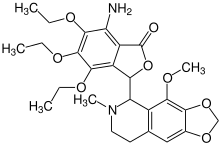Tritoqualine
Appearance
 | |
| Clinical data | |
|---|---|
| AHFS/Drugs.com | International Drug Names |
| ATC code | |
| Identifiers | |
| |
| CAS Number | |
| PubChem CID | |
| ChemSpider | |
| UNII | |
| CompTox Dashboard (EPA) | |
| Chemical and physical data | |
| Formula | C26H32N2O8 |
| Molar mass | 500.548 g·mol−1 |
| 3D model (JSmol) | |
| |
Tritoqualine, also known as hypostamine, is an inhibitor of the enzyme histidine decarboxylase and therefore an atypical antihistamine, used for the treatment of urticaria and allergic rhinitis[1] with no known adverse effects.[citation needed]
References
- ^ Randomized, placebo controlled study of tritoqualine (hypostamine*) in the treatment of perennial allergic rhinitis. A. Pradalier, V. Hentschel, S. Prouzeau, D. Legallais, G. Lefrançois. Revue Française d’Allergologie et d’Immunologie Clinique 43:175-179 (2003)
